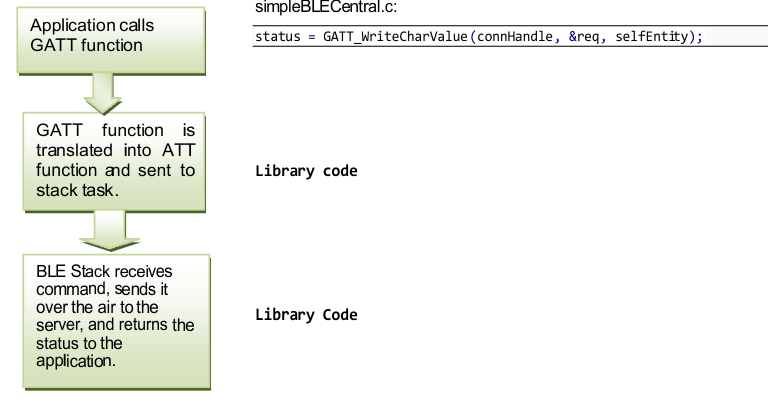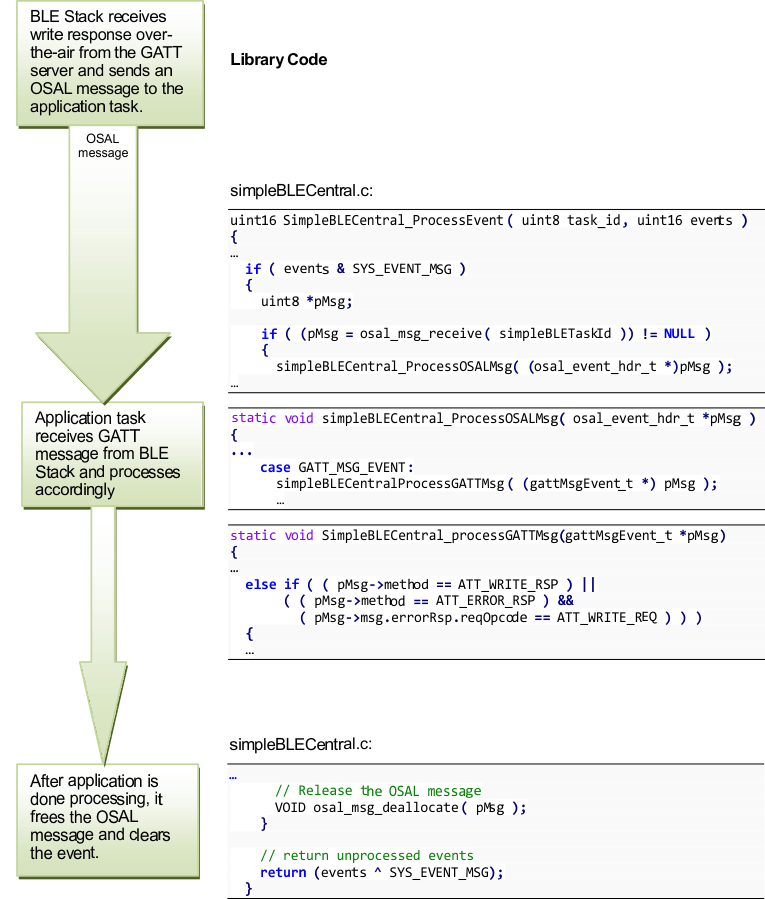SWRU271I October 2010 – January 2020 CC2540 , CC2540T , CC2541 , CC2541-Q1 , CC2640R2F
- Preface
- 1Overview
- 2The TI Bluetooth Low Energy Software Development Platform
- 3The Operating System Abstraction Layer (OSAL)
- 4The Application and Profiles
-
5The Bluetooth Low Energy Protocol Stack
- 5.1 Overview
- 5.2 Generic Access Profile (GAP)
- 5.3 GAPRole Task
- 5.4 Gap Bond Manager (GAPBondMgr)
- 5.5
Generic Attribute Profile (GATT)
- 5.5.1 GATT Characteristics and Attributes
- 5.5.2 GATT Services and Profile
- 5.5.3 GATT Client Abstraction
- 5.5.4 GATT Server Abstraction
- 5.6 L2CAP
- 5.7 HCI
- 5.8 Library Files
- 6Drivers
- 7Creating a Custom Bluetooth Low Energy Application
- 8Development and Debugging
-
9General Information
- 9.1 Overview
- 9.2 Porting From BLE-Stack 1.5.0 to 1.5.1
- 9.3 Porting From BLE-Stack 1.4.2 to 1.5.0
- 9.4
Porting From Earlier BLE-Stack Versions
- 9.4.1 Porting BLEv1.4.1 Projects to BLEv1.4.2
- 9.4.2 Porting BLEv1.4.0 Projects to BLEv1.4.1
- 9.4.3 Porting BLEv1.3.2 Projects to BLEv1.4.0
- 9.4.4 Porting BLEv1.2 Projects to BLEv1.3
- 9.4.5 Porting From CC2540 to CC2541 Project
- 9.5 Release Notes History
- 9.6 Document History
- A GAP API
- B GAPRole Peripheral Role API
- C GAPRole Central Role API
- D GATT/ATT API
- E GATTServApp API
- F GAPBondMgr API
- G HCI Extension API
- Revision History
5.5.3.1 Using the GATT Layer Directly
This section describes how to use the GATT layer directly in the application. The functionality of the GATT layer is implemented in the library code but you can find the header functions can in gatt.h. You can find the complete API for the GATT layer in Section D. You can find more information on the functionality of these commands in the Device Information Service (Bluetooth Specification), version 1.0 (24-May-2011). GATT client applications uses these functions primarily. A few server-specific functions exist which are described in the API and not considered here. Most GATT functions return ATT events to the application, so consider the ATT API in Section D. Perform the following procedure to use the GATT layer when functioning as a GATT client (that is, in the SimpleBLECentral project):
- Initialize the GATT client. Do this in the application initialization function.
- Register to receive incoming ATT indications and notifications. Do this in the application initialization function.
- Perform a GATT client procedure. The following example uses GATT_WriteCharValue(), which is triggered by pressing the key on the left in the SimpleBLECentral application.
- Receive and handle the response to the GATT client procedure in the application. In the following example, the application receives an ATT_WRITE_RSP event. For a list of GATT commands and their corresponding ATT events, see Section D.6.
- Ensure the GATT client is registered to receive these ATT events in step 2.




NOTE
Though the event sent to the application is an ATT event, it is sent as a GATT protocol stack message (GATT_MSG_EVENT).
Besides receiving responses to its own commands, a GATT client may also receive asynchronous data from the GATT server as indications or notifications.
These events will also be sent as ATT events in GATT messages to the application and should be handled as described in this procedure.